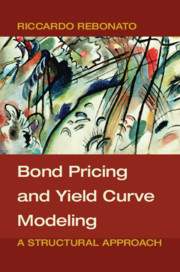Book contents
- Frontmatter
- Dedication
- Contents
- Acknowledgements
- Symbols and Abbreviations
- Part I The Foundations
- 1 What This Book Is About
- 2 Definitions, Notation and a Few Mathematical Results
- 3 Links among Models, Monetary Policy and the Macroeconomy
- 4 Bonds: Their Risks and Their Compensations
- 5 The Risk Factors in Action
- 6 Principal Components: Theory
- 7 Principal Components: Empirical Results
- Part II The Building Blocks: A First Look
- Part III The Conditions of No-Arbitrage
- Part IV Solving the Models
- Part V The Value of Convexity
- Part VI Excess Returns
- Part VII What the Models Tell Us
- References
- Index
1 - What This Book Is About
from Part I - The Foundations
Published online by Cambridge University Press: 25 May 2018
- Frontmatter
- Dedication
- Contents
- Acknowledgements
- Symbols and Abbreviations
- Part I The Foundations
- 1 What This Book Is About
- 2 Definitions, Notation and a Few Mathematical Results
- 3 Links among Models, Monetary Policy and the Macroeconomy
- 4 Bonds: Their Risks and Their Compensations
- 5 The Risk Factors in Action
- 6 Principal Components: Theory
- 7 Principal Components: Empirical Results
- Part II The Building Blocks: A First Look
- Part III The Conditions of No-Arbitrage
- Part IV Solving the Models
- Part V The Value of Convexity
- Part VI Excess Returns
- Part VII What the Models Tell Us
- References
- Index
Summary
It is not my intention to detain the reader by expatiating on the variety, or the importance of the subject, which I have undertaken to treat; since the merit of the choice would serve to render the weakness of the execution still more apparent, and still less excusable. But […] it will perhaps be expected that I should explain, in a few words, the nature and limits of my general plan.
Edward Gibbon, The Decline and Fall of the Roman EmpireMY GOAL IN WRITING THIS BOOK
In this book I intend to look at yield-curve modelling from a ‘structural’ perspective. I use the adjective structural in a very specific sense, to refer to those models which are created with the goal of explaining (as opposed to describing) the yield curve. What does ‘explaining’ mean? In the context of this book, I mean accounting for the observed yields by combining the expectations investors form about future rates (and, more generally, the economy) and the compensation they require to bear the risk inherent with holding default-free bonds. (As we shall see later, there is a third ‘building block’, ie, convexity.)
This provides one level of explanation, but one could go deeper. So, for instance, the degree of compensation investors require in order to bear ‘interestrate risk’ could be derived (‘explained’) in more fundamental terms from the strategy undertaken by a rational, risk-averse investor who is faced with a set of investment opportunities and wants to maximize her utility from consumption in amultiperiod economy. I will sketch with a broad brush the main lines of this fundamental derivation, but will not pursue this line of argument in great detail. The compensation exacted by investors for bearing market risk (the ‘market price of risk’) will instead be empirically related (say, via regressions) either to combinations of past and present bond prices and yields, or to past history and present values of macroeconomic variables.
Another way to look at what I try to do in this book is to say that I describe the market price of risk in order to explain the yield curve. If one took a more ‘fundamental’ approach, one could try to explain the market price of risk as well, but would still have to describe something more basic, say, the utility function.
Information
- Type
- Chapter
- Information
- Bond Pricing and Yield Curve ModelingA Structural Approach, pp. 3 - 23Publisher: Cambridge University PressPrint publication year: 2018
